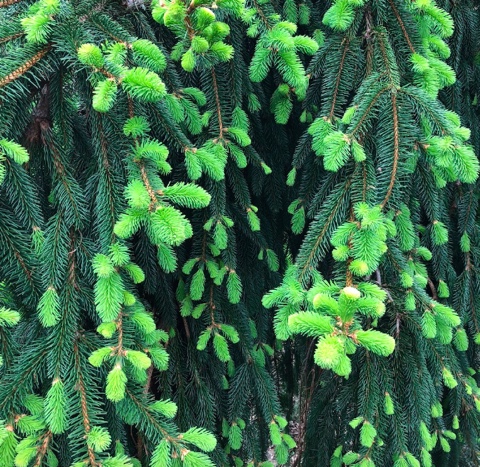At my mom’s, outside the sliding-glass door in her living room, across the narrow stone patio and a swath of grass bright green from recent rain, there is a cherry tree. Cornus mas. It is about 20 feet tall and just as wide. The blossoms are a soft baby pink, with the slightest hint of sweetness.
The tree bloomed beautifully this year, aided by a strong wind the winter before last that felled a giant pine and brought the cherry tree the sunlight the pine had hoarded. The cherry tree was in bloom for two weeks this year, petals growing paler and thinner and more ruffled until they let go and fell blowsy to earth in a soft rain of pink that puddled at the base of the tree.
Last night I dreamed about those petals but they weren’t falling on the grass, they were falling in my mother’s living room, on her petite oyster white leather couch that we bought (“Can you believe exactly what we need is 75% off?”) when she moved in, on her floating wood floor that reprimands with a loud yelp if I drop Leda’s collar, on her dining table that is set perpendicular to the sliding-glass door, the table where for lunch she eats the salad from dinner the night before, where she addresses the envelope to her bank to deposit a check, where she runs her curled finger down the resident directory as she searches for a phone number to make plans for brunch or bridge or to sort estate jewelry for the thrift shop sale.
My mother has a scooter now. When she moved in she looked at residents speeding by and spat, “I’ll never get one of those.” But it is a half-mile walk to the cafe and a half-mile back. She used to walk it easily. Now she needs to pause on the way home at least twice, sometimes three times, to rest in one of the chairs that populate the wide, green plaid-carpeted hallways at thoughtful intervals.
Mom’s plan has always been to live to at least one hundred, because all her friends told her she would, because her parents both lived to ninety-nine, and because she was healthy and strong. We went to the hospital two weeks ago so doctors could look inside her heart, to know its condition with more precision than given by the echocardiogram and the nuclear medicine test. My mother said, “They didn’t find anything from all those other tests and I don’t think they’ll find anything now.”
After the procedure, the doctor found me and sat with me in the waiting room and said, “Let’s talk about your mother’s heart.” I listened and told him that this news would be a surprise to her. We talked about treatment options and then went to see my mother. When he said, “Your heart is 95% blocked on one side and 95-99% blocked on the other,” I saw something I had read about but never seen—the blood drained from her face. She was as pale as the hospital blanket pulled up under her chin. But I saw something else too, something I have never read about. I saw the wrinkles drain from her face. She no longer looked like an elderly woman, she had the face of a baby. I reached out for her hand and she surprised me by taking mine. My mother was never good at touch and stayed true to form. She didn’t hold my hand but clamped it, like a C-clamp gripping a board. Her middle fingernail bit in to the soft crease of my middle finger and I was glad to be able to offer a small comfort.
My mother has had to recalibrate—to a scooter, to nitroglycerin, to baby aspirin, to possibly being wrong about having another decade on the planet. The cherry blossoms in my dream were a message to me, that even though my mother has always been here she will not always be here and someday, neither will I.

* * *
Chewing the Cud of Good
The blessing of the big wind that felled the giant pine was that daylight could now enter my mother’s apartment. The curse was that the views from the sliding-glass doors in her living room and bedroom were now completely open to the eyes of the apartment across the courtyard. My mother felt exposed, vulnerable. She responded by keeping the blinds she had drawn for the night closed during the day.
My mom asked a year ago for a tree to replace the one that had fallen but no tree was forthcoming. It took months to saw and haul the giant fallen tree, more months to seed the lawn. Then it was winter. But this spring the retirement community is preparing to expand and is seeking sites for trees it needs to relocate. Because it is a certified arboretum they can’t just cut them down.
The arborist asked my mother to come with him to look at a certain tree, to see if she liked it. He said, “Most people love them or hate them and I’m not spending the money to move it if you don’t like it.” He picked mom up in his little golf cart and took her to the tree. He asked what she thought. She looked at it, carefully. He waited. “I think it’s beautiful,” she said.
The tree is a weeping Norway spruce, seven feet tall and eight feet wide. It was planted the day after mom came home from the hospital the first time. It fully blocks the view from her neighbors and it will continue to do so in the winter, when the leaves of deciduous trees have fallen. I talked to the tree before it was moved, told it where it was going and why it meant so much to my mother. The tree understood and to prove it, the tree is growing as if it had never been moved.

PS: At lunch at her table by the sliding-glass door we had this conversation:
Me: The tree looks great. It’s really growing.
Mom: It does. I’ve been talking to it.
Me: Good! What do you say?
Mom: I tell it how pretty it looks, how happy it will be to live here.